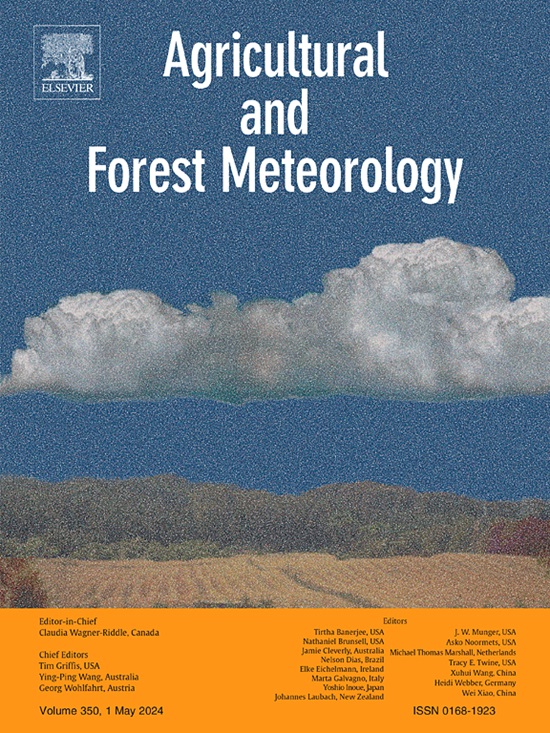Quantifying the impacts of environmental stress factors on biogenic volatile organic compound emissions in China
IF 5.7
1区 农林科学
Q1 AGRONOMY
引用次数: 0
Abstract
Biogenic volatile organic compounds (BVOCs) are key precursors to ozone (O₃) and secondary organic aerosol (SOA) formation, influencing both air quality and climate changes. BVOC emissions are highly responsive to environmental stressors such as drought, temperature, and ozone. While significant progress has been made in modeling BVOC emissions, existing studies in China lack a detailed exploration of how different abiotic stressors—particularly in combination—affect emissions and their subsequent impacts on O₃ and SOA formation. In this study, we employed the MEGAN 3.2 model to quantify the effects of different stressors (drought, temperature, ozone, CO₂, wind, and LAI) on BVOC emissions across China during 2019. Seven scenario simulations were conducted, each isolating individual stressors as well as a combined scenario. Our results show that drought and ozone significantly alter emissions, reducing isoprene and monoterpene output while increasing SOA formation under certain conditions. The largest impacts were observed in Central and Eastern China, where combined stressors led to reductions in BVOC emissions by up to 25 % during summer months. This study provides new insights into how different abiotic stressors interact to influence BVOC emissions and air quality in China. The findings highlight the need for integrated stressor assessments in emission models to better predict O₃ and SOA concentrations under future climate scenarios. These results contribute to advancing air quality management strategies, particularly in regions facing increasing environmental stress due to climate change.
环境胁迫因子对中国生物源性挥发性有机物排放影响的量化研究
生物源性挥发性有机化合物(BVOCs)是臭氧(O₃)和二次有机气溶胶(SOA)形成的关键前体,影响空气质量和气候变化。BVOC的排放对干旱、温度和臭氧等环境压力非常敏感。虽然在模拟BVOC排放方面取得了重大进展,但中国现有的研究缺乏对不同的非生物压力源(特别是组合)如何影响排放及其对O₃和SOA形成的后续影响的详细探索。在本研究中,我们采用MEGAN 3.2模型量化了2019年中国不同压力源(干旱、温度、臭氧、CO 2、风和LAI)对BVOC排放的影响。进行了七个场景模拟,每个场景都隔离了单个压力源以及组合场景。我们的研究结果表明,干旱和臭氧显著改变了排放,减少了异戊二烯和单萜烯的产量,同时在一定条件下增加了SOA的形成。在中国中部和东部观察到的影响最大,在夏季,综合压力因素导致BVOC排放量减少高达25%。该研究为了解不同非生物应激源如何相互作用影响中国BVOC排放和空气质量提供了新的见解。研究结果强调了在排放模型中进行综合压力源评估的必要性,以便更好地预测未来气候情景下O₃和SOA的浓度。这些结果有助于推进空气质量管理战略,特别是在因气候变化而面临日益严重的环境压力的地区。
本文章由计算机程序翻译,如有差异,请以英文原文为准。
求助全文
约1分钟内获得全文
求助全文
来源期刊
CiteScore
10.30
自引率
9.70%
发文量
415
审稿时长
69 days
期刊介绍:
Agricultural and Forest Meteorology is an international journal for the publication of original articles and reviews on the inter-relationship between meteorology, agriculture, forestry, and natural ecosystems. Emphasis is on basic and applied scientific research relevant to practical problems in the field of plant and soil sciences, ecology and biogeochemistry as affected by weather as well as climate variability and change. Theoretical models should be tested against experimental data. Articles must appeal to an international audience. Special issues devoted to single topics are also published.
Typical topics include canopy micrometeorology (e.g. canopy radiation transfer, turbulence near the ground, evapotranspiration, energy balance, fluxes of trace gases), micrometeorological instrumentation (e.g., sensors for trace gases, flux measurement instruments, radiation measurement techniques), aerobiology (e.g. the dispersion of pollen, spores, insects and pesticides), biometeorology (e.g. the effect of weather and climate on plant distribution, crop yield, water-use efficiency, and plant phenology), forest-fire/weather interactions, and feedbacks from vegetation to weather and the climate system.

 求助内容:
求助内容: 应助结果提醒方式:
应助结果提醒方式:


